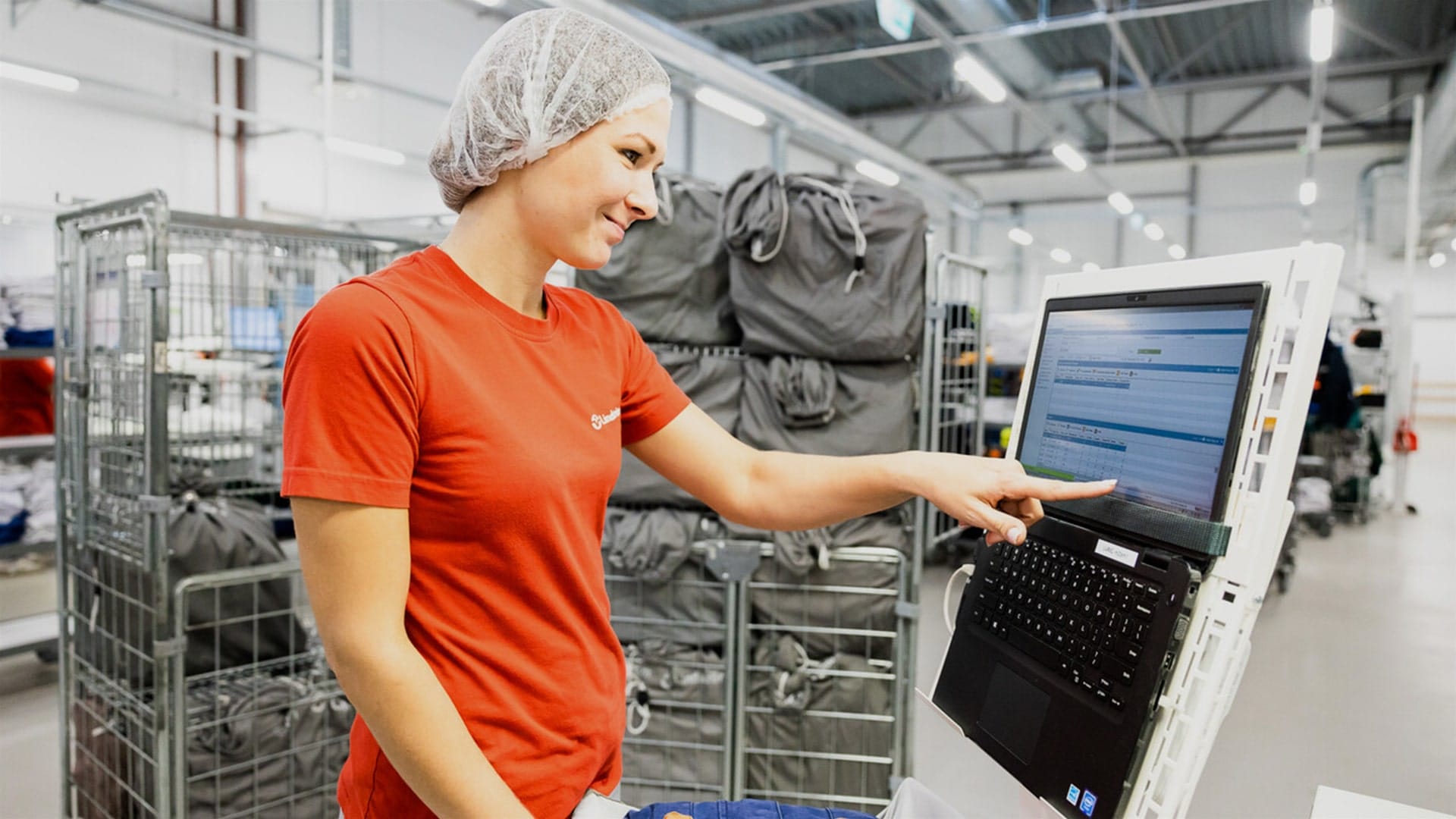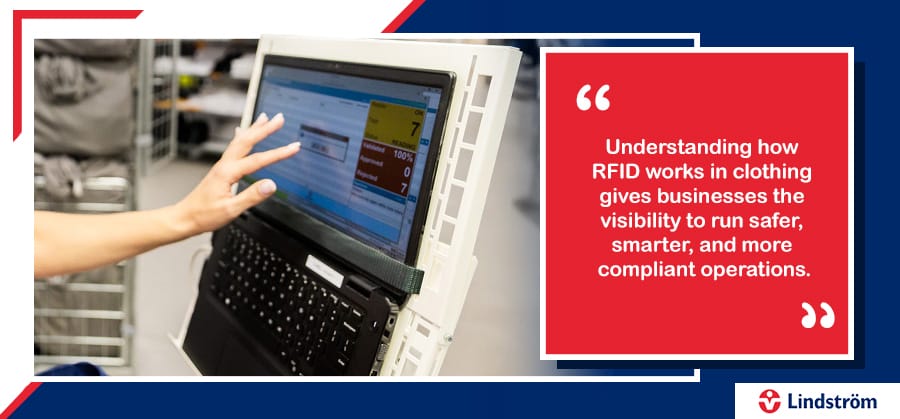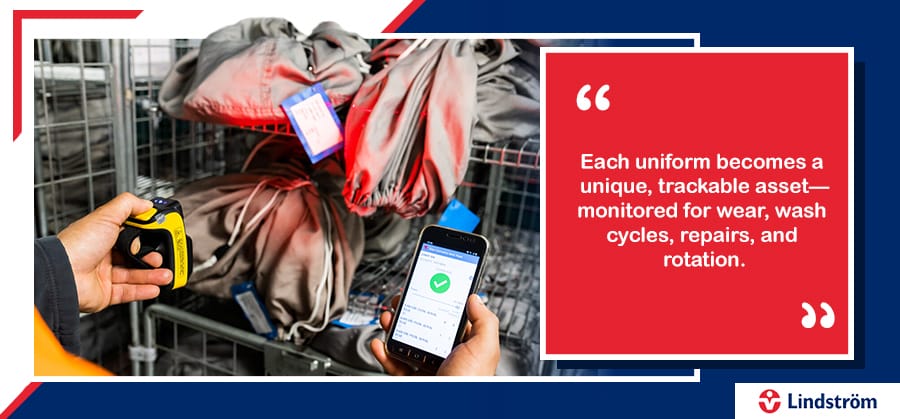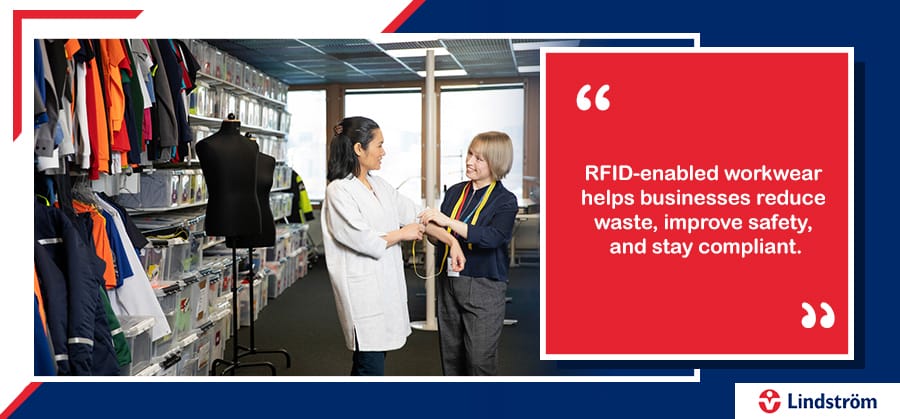
RFID Technology in Workwear: How Smart Uniform Tracking Optimises Workplace Processes
RFID technology is transforming how industries manage uniforms, safety, and inventory. RFID garment rental systems are helping organisations streamline operations, ensure compliance, and reduce costs across large workforces.
This guide explains how RFID chips work, how they’re used in clothing, and how a system like Lindström’s RFID uniform tracking can improve operational visibility and efficiency.
What Is an RFID Chip and How Does It Work?
RFID (Radio Frequency Identification) is a wireless communication technology that uses radio waves to read and capture information stored on tags embedded in objects—including garments.
How does an RFID chip work?
An RFID chip stores a unique digital identifier and responds to signals from a reader device.
When the reader sends out a signal, the chip transmits its stored information without needing a line-of-sight, unlike traditional barcodes.
Components of an RFID system
| Component | Function |
| RFID tag (chip) | Stores and transmits data about the garment |
| RFID reader | Sends signals to the tag and receives its response |
| Software system | Processes and logs the data for tracking and reporting |
| Database | Stores garment histories, repairs, and assignment data |
This technology enables seamless, accurate, and contactless uniform tracking.

What Is an RFID Tag in Clothes?
An RFID tag in clothing is a small chip embedded into the garment—usually sewn into a seam, collar, or internal label.
Designed to withstand industrial laundering, these tags allow each item of clothing to be uniquely identified and tracked throughout its lifecycle.
This is particularly valuable in industries where garment cleanliness, condition, and traceability are legally or operationally critical, such as:
- Healthcare
- Food production
- Manufacturing
- Facilities management
- Transport and logistics
How Does RFID Work in Clothing Rental?
Lindström integrates RFID chips into every rented garment. These chips hold unique digital IDs linked to the employee, department, and garment type.
The process typically includes:
- Garments are tagged during production
- Clothing is scanned at delivery, collection, and during every laundry cycle
- The system logs activity, including frequency of use, wear and tear, repairs, and replacements
- Employers can access uniform data through a secure online platform
This provides total visibility over your uniform inventory and performance without manual tracking.

Benefits of an RFID Uniform Tracking System
1. Accurate Garment Traceability
Every uniform has a clear digital trail—who it belongs to, when it was last laundered, and whether it’s in use, being repaired, or due for replacement.
2. Improved Inventory Control
Avoid over-ordering, garment shortages, or size mismatches. Maintain the optimal number of garments per employee.
3. Reduced Loss and Misuse
By tracking every item individually, losses are minimised, and misuse is easier to identify and prevent.
4. Insight into Wear Patterns and Repairs
Monitor repair frequency and garment age to help with safety assessments, cost management, and forecasting.
5. Seamless Reporting for Compliance and Audits
Through the eLindström system, managers can view:
- Garment assignments by person, size, and role
- Total items in circulation
- Repair logs and wash cycles
- Invoice and order history
- Remaining garment lifecycle or replacement needs
All of this supports health and safety audits, hygiene control, and quality assurance.
Example: RFID Garment Rental in Manufacturing
In a mid-sized automotive parts manufacturing plant with 150 employees:
- Uniforms are issued to staff based on role and shift
- RFID tracks washing cycles to ensure hygiene standards
- Missing or damaged items are flagged and replaced automatically
- Site managers access reports weekly to monitor usage and costs
This ensures high levels of hygiene, zero garment shortages, and simplified stock management—without manual admin.

Why RFID Garment Rental Makes Business Sense
Uniform management can be time-consuming and costly without an efficient system.
RFID workwear rental gives you the tools to control stock, ensure availability, and support compliance, while outsourcing the laundry and upkeep.
Advantages include:
- Professional laundering that maintains garment performance
- Full lifecycle tracking of each uniform
- No more garment loss, overstocking, or missing sizes
- Operational savings through automated reporting
- Better employee satisfaction with reliable, well-fitting clothing
Final Thoughts
Understanding how RFID works in clothing provides key advantages in industries where hygiene, safety, and efficiency are critical.
With RFID-enabled garments and software systems, businesses can achieve full control over uniform tracking—reducing waste, improving safety, and enhancing compliance.
To find out how Lindström’s RFID uniform tracking system can support your workplace, get in touch with us today.




